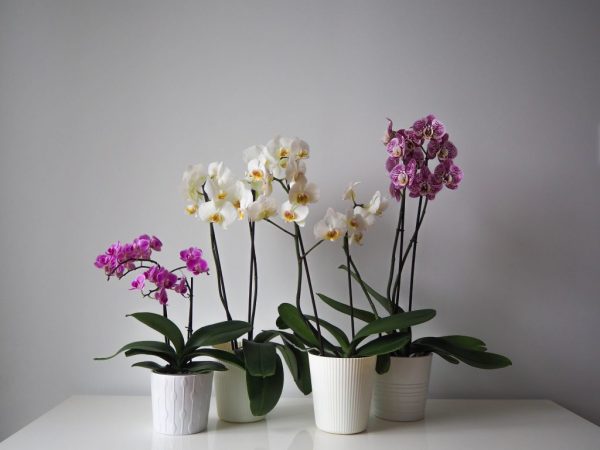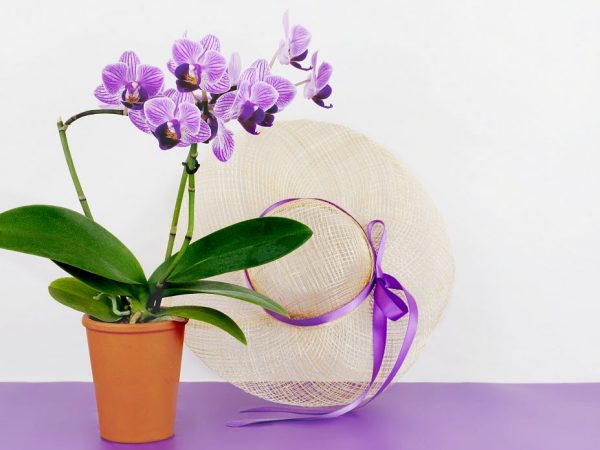Choosing planters for orchids
The orchid planter is a decorative vase for indoor plants that does not have holes for draining excess water. The choice of such a container for growing orchids is approached responsibly.

Choosing planters for orchids
Requirements for pots
When choosing a planter for an orchid, it is important to consider the following points:
- the width of the pots should be larger than the pot so that air circulation is not disturbed and the soil can dry out;
- in order to remove excess moisture in one place at the bottom there should be a recess;
- the container should be suitable for the design of the room for greater impact.
The size of the pot should be 2-3 cm larger than the size of the root system, and the pots should be the same distance so that a layer of air remains.
There are floor and hanging pots. The only question is which of them will fit. Of great importance is the material of the pot, which is placed in the pots, because this significantly affects the life of the flower.
Orchid pots are usually made of several materials: glass, transparent or opaque plastic, clay, etc. It is practical to use transparent plastic pots for phalaenopsis, because it is possible to monitor the condition of the soil and root system in order to carry out timely watering and monitor the presence of parasites, the roots do not grow to such material, helps to avoid hypothermia, and maintains the humidity of the environment well. However, there are disadvantages: plastic does not allow air to pass through at all, phalaenopsis has no stability, when watering by immersion, the flower can be pushed out along with the root system.
Clay vessels are used less often than plastic, but they prevent stagnation of water, which is important for maintaining the health of the roots, they distribute it perfectly, the pot itself is stable. But it is important to take into account that at elevated air temperatures, clay pots are not suitable, because the level of evaporation increases, and the roots themselves grow firmly into this material. Ceramics replaces the previous type well, and the roots do not grow to it. The main disadvantage is that ceramics is a cold vessel that will destroy the sensitive underground parts of the flower.
Planting orchids in pots without draining
To plant orchids in a container without draining, certain rules must be followed.
- The plant must be healthy and strong.
- The substrate should meet the optimal requirements of orchids, including small pieces of coniferous bark, charcoal, expanded clay, etc.
- The planter is chosen so that it matches the size of the phalaenopsis root system, slightly constraining it.
- It is advisable to transplant after the end of the flowering period. If it is carried out for decorative purposes, then the contents of the old vessel are carefully transferred to a new one.
- On the upper layer of the substrate there should be sphagnum moss, which protects the integument from washing out.
Do-it-yourself planter for a plant

The pot can be either purchased or homemade
Anyone can create a beautiful and practical vessel for indoor plants with their own hands.If it is made from plywood or blocks, you should make several pieces of the same size and fasten with a hot gun or glue, and then smooth the edges with sandpaper to make them smooth. It is worth covering the plywood with oil or acrylic paint.
The container is made with your own hands from the remaining ceramic tiles and concrete, using the popular mosaic technique, so that it does not look boring. Pipes, burlap are also used, and large shells, stumps, wicker vines, and coconut shells are popular among natural materials. If this does not seem original enough, then you should think about using old unnecessary things. A suitcase, tin cans, used floppy disks and records, hats, plastic bottles, car tires and even pieces of furniture are suitable for this.
Using a glass planter
The use of glass pots remains a big question, because no drainage holes can be made in this material to release excess moisture. However, this problem is completely solvable. For this, double containers are created - a glass pot is placed in a planter.
Because the glass is transparent, the grower has the ability to monitor the state of the substrate and roots and prevent excessive watering. In the case of orchids, it is better to dry out the soil of the plant a little than to flood it.
Useful Tips
- You cannot plant an orchid directly into a heavy ceramic vessel, this is harmful to the supporting apparatus of the plant.
- The pot inside must have a large number of drainage holes.
- There should be an air gap between the inner pot and the planter to promote active aeration.
- During the life of a flower, much less salts are deposited on the walls of plastic vessels than on clay pots.
- For beginners, flower growers are advised to use transparent plastic orchid planters so that they can comfortably monitor the condition of the soil and phalaenopsis roots.
- For any capacity, the use of an abundant amount of drainage material is justified.
- Glass vessels are recommended for use by experienced flower growers.
- In order not to risk the health of the plant, you need to choose containers with a recess for excess water.
- Choose light or, conversely, heavy containers so as not to hinder the growth and development of the flower.
- The pot with the plant should be located in a well-lit place, but at the same time provide protection from the harmful effects of ultraviolet radiation.
Conclusion
To grow phalaenopsis, you need to choose or make your own hands a container that will satisfy all the needs of the flower and allow it to bloom for many years and delight the owner.


